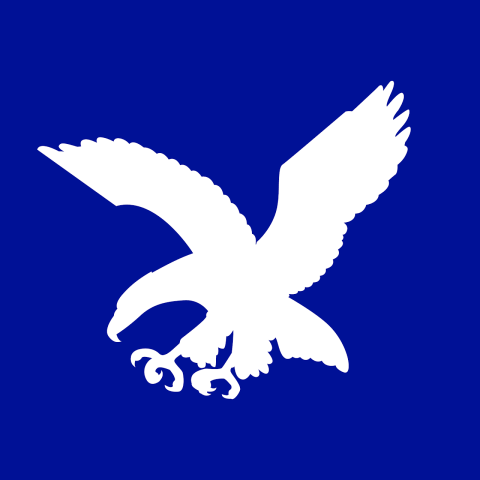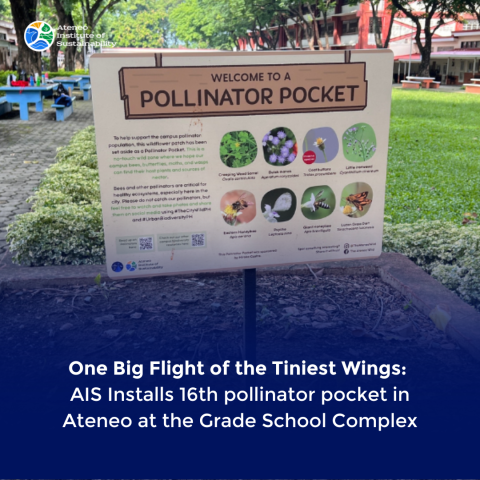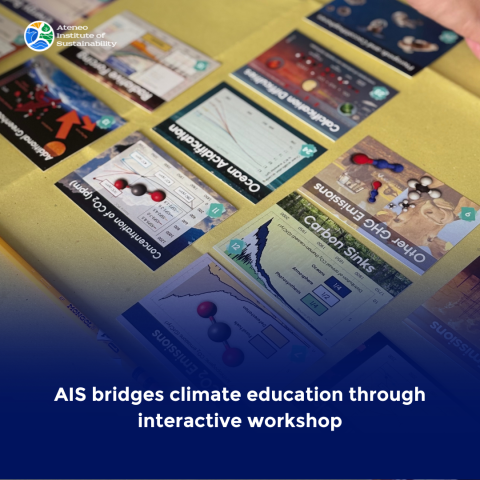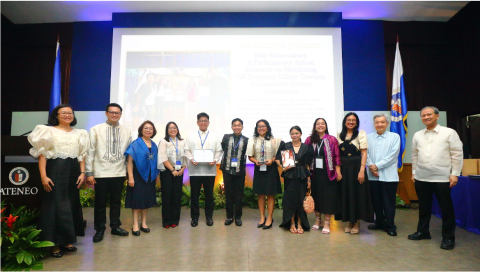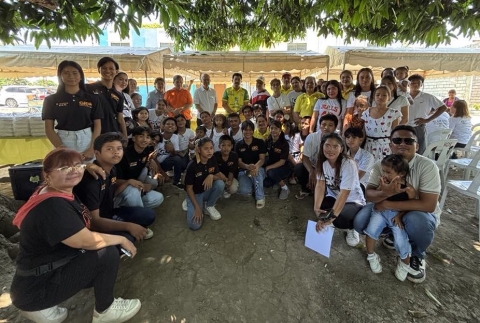Areté Sandbox welcomes its latest batch of residents
28 Jan 2025 | Franz Co, resident writeups by Karlo Erfe
 On 22 February, the Sandbox at Areté, Ateneo de Manila University, held its kickoff event for the 2025 cycle of its residency program. Here it welcomed its latest batch of residents and student challenge groups.
On 22 February, the Sandbox at Areté, Ateneo de Manila University, held its kickoff event for the 2025 cycle of its residency program. Here it welcomed its latest batch of residents and student challenge groups.
The Sandbox Residency Grant supports innovative, collaborative initiatives that combine research, artistic processes, and community engagement beyond the academic setting. The program provides residents the resources for experimentation, ideation, and incubation to explore innovative ideas and develop creative solutions to addressing various societal problems.
For this incoming cycle, Sandbox welcomed nine residents and four student challenger groups. Their projects had to follow the themes of "Philippine Education Reform," "Data-Driven Urban Resilience," and Sustainable Development" (in collaboration with the Ateneo Institute of Sustainability).

Upon being selected, the residents received Php 100,000 working capital plus a Php 50,000 space-use grant for Areté facilities. In addition, they are given priority access to the Eugenio Lopez Jr Makerspace including access to 3D printers; dedicated workspace in the Eduardo J Aboitiz Sandbox Zone for the entire residency period; and access to workshops on creative thinking, ideation, and problem-solving.
AI-Assisted Bone Fragment Analysis: Transforming Education in Forensics, Archaeology, and Medicine
The AI-Assisted Bone Fragment Analysis platform transforms learning in forensics, archaeology, and medicine through AI-powered bone recognition, 3D models, and gamified learning. Accessible via smartphones and VR, it enables hands-on exploration and cross-disciplinary collaboration. This innovative tool makes advanced skeletal analysis easier, more engaging, and widely available.
Developing Evidence-Informed Digital Materials To Prevent Bullying
In partnership with the Department of Education, this project aims to develop digital materials on bullying prevention. Using a human-centered design process, multi-disciplinal teams if college students will work with public school students in ideating, prototyping and evaluating tools that can be used in making our schools safer and more inclusive.
KLIMA: Approaches to Climate Literacy
The KLIMA: Approaches to Climate Literacy project develops climate education toolkits for primary school teachers by blending literature, climate science, and local narratives. It empowers educators to teach climate change through culturally relevant stories, fostering empathy and critical thinking in students. This interdisciplinary approach equips learners to address climate challenges while connecting to their cultural heritage.
Living Barrens: The biodiversity of sand and rubble habitats in popular muck diving spots of the Verde Island Passage
The Living Barrens project studies the biodiversity of soft-sediment habitats (SSHs) in popular muck diving areas of the Verde Island Passage, focusing on the fish and invertebrates that inhabit these ecosystems. Through scientific surveys and visual media, the project aims to raise awareness and promote the conservation of these vital, yet often overlooked, marine environments. The findings will support sustainable tourism and ecosystem protection in the Philippines.
Pawikan Do It Together! Addressing the challenges of sea turtle conservation through an NGO-student org collaboration
"Pawikan Do It Together!" is a collaborative initiative between the Ateneo Environmental Science Society (AESS) and the Pawikan Conservation Center (PCC) to enhance sea turtle conservation efforts. The project focuses on creating educational materials, citizen science opportunities, and monitoring protocols to improve public engagement and increase the Center's impact. Through interactive exhibits, educational talks, and hands-on activities, the project aims to raise awareness and inspire action for sea turtle conservation within the Ateneo community and beyond.
Project Kalikhasaan
Project Kalikhasaan is an arts-based initiative aimed at raising ecological awareness in urban areas. Through a nature journal, participants reflect on their surroundings by creating visual and literary art, promoting a deeper connection to urban sustainability. The project fosters a community of eco-journalers dedicated to environmental action and awareness.
The Role We Play: APOAMF’s People’s Plan, the Academe, and the UNSDGs
The Role We Play project empowers the Alliance of Peoples’ Organization along the Manggahan Floodway’s (APOAMF) community to advance climate-resilient housing through a collaborative, interdisciplinary approach. By combining design thinking and the arts, it fosters youth leadership and strengthens the community’s advocacy for sustainable urban housing. This initiative bridges academic and grassroots efforts to address urban poverty and climate change.
The Well-being Project
The Well-being Project explores Filipino children's self-perception of emotional well-being through creative workshops like storytelling and role-playing. Led by a team of researchers, the project empowers children to share their experiences and co-create a culturally relevant definition of well-being. Ultimately, it aims to inform policies and promote mental health awareness in the Philippines.
MACC: Crystallographic Symmetries Y2
Crystallographic Symmetries in Repeating Patterns in the Klein Bottle and Tboli Baskets connects mathematics, art, and culture through innovative educational materials. It combines laser-engraved models, indigenous weaving patterns, and 3D designs to teach symmetry while promoting Philippine cultural heritage. The next phase aims to expand these efforts through workshops and instructional tools that enrich mathematics education and inspire educators.

In addition to the residents, Sandbox also welcomed four projects for its Student Challenge. This program offers undergraduate students the resources to dive headfirst into uncharted territory. The selected challengers each receive Php 25,000 in working capital plus a Php 50,000 space-use grant for Areté facilities; priority access to the Eugenio Lopez Jr Makerspace; dedicated workspace in the Eduardo J Aboitiz Sandbox Zone for the entire Residency period; and mentorship from an industry expert.
Concrete Jungle 2.0: Reengineering Urban Resilience through Ancient Knowledge
Concrete Jungle 2.0 combines ancient Roman concrete techniques with modern bio-based materials like volcanic ash and chitosan to create self-healing concrete for coastal cities. This solution reduces maintenance costs, enhances resilience against extreme weather, and promotes sustainability. By adapting to local conditions, it aims to transform urban infrastructure and strengthen cities against climate change.
Mapping Sustainability: Integrating Geospatial Data in the Loyola Schools’ Campus Mobility and Energy Consumption
Mapping Stories: Integrating Geospatial Data in the Loyola Schools' Campus Mobility aims to utilize geospatial frameworks to design an interactive map of the Loyola School campus that "tells stories". By combining quantitative patterns of our community's foot traffic with qualitative aspects of how people perceive and connect with our spaces, we strive to offer a new perspective for Ateneo's future campus infrastructure proposals — aiming for a better and safer tomorrow.
Project Habi: An Ecological and Participatory Community Art Project
Project Habi is a community art project designed to help young people cope with climate anxiety through collaborative workshops and sustainable art-making. By fostering solidarity and dialogue, it empowers participants to express their experiences and take collective action on climate change. The project culminates in an exhibition and zine to amplify youth voices and inspire positive environmental action.
WaterFALL: Water For All
WaterFALL: Water For All is developing an atmospheric water generator to aid communities that lack access to clean and consistent water. The team’s generator's modular design will be motivated by our principles of adaptability, accessibility, and ease of use which will allow its implementation to remain widespread. Throughout their residency, they are committed to documenting the entire development process on social media to instruct and emphasize to the public the importance of pursuing solutions.
As part of the event, the incoming residents and student challengers for 2025 signed their memorandums of agreement with Sandbox.
In addition to welcoming the new batch, the event also served as a farewell to the outgoing residents and student challengers, who were given time to present the results of their projects.
